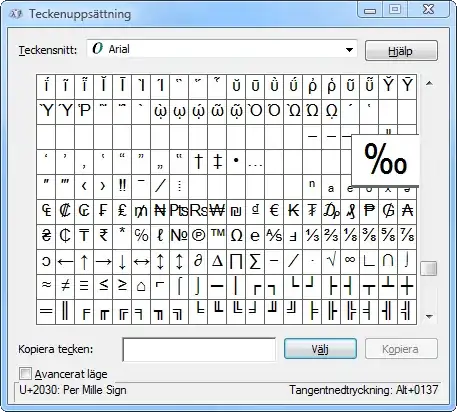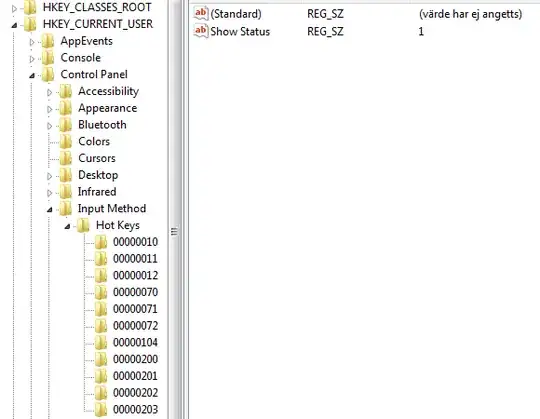I can use Charmap utility in Windows to find, copy, and paste the character in any application, including web browsers. But what is the Alt key combination to type in the infinity character?
http://answers.yahoo.com/question/index?qid=20080726061303AA3ZWrr
This Yahoo Answers page says I should use Alt+236 but this only results in a lower case acute Y, like this: ý
I get the same result in Firefox, Excel and Word.
Inserting infinity symbol in Powerpoint 2010
This Superuser page says that the Unicode value for the infinity character is 221e. Does that mean that the Alt key combination is Alt+221? If I use this combination I get this character: ¦
That's a "broken vertical line".
http://www.forlang.wsu.edu/help/keyboards.asp
On this page they are using 4 digits in their Alt key combinations. Does this mean that my Alt key combinations should begin with a zero? Like Alt+0137 for permille ‰ character. I also noticed that they are using Alt+0253 for lower case ý character.
So what's going on? And how do I get the correct Alt key combination for the infinity character?
Update
It looks like there is no Alt key binding for the infinity character on my computer. I forgot that the Charmap utility shows you the Alt key combinations. This is what it says for the permille character and the infinity character. See the screenshots below.


As you can see there is an Alt key combination for the permille character. The combination Alt+0137 is used for permille, just like described on that other web page. But notice that there is no Alt key combination listed for the infinity sign.
Why is that? Is it my version of Windows? Is it my keyboard? My keyboard layout? My keyboard language and locale in Windows?
This ultimately leads me to this question: is there a free software application I can use to modify and create my own Alt key bindings for whatever characters I want?
Update 2
This is the contents of my Input Method key in Windows registry.

So as you can see I don't have such thing as EnableHexNumpad.
Update 3
Alright, so I have gone through the trouble of adding this key with the string value of 1 and rebooted the computer.

I think the changes are applied now. How do I know? Because when I press Alt and the plus key on the number pad the menu options on the top of the window in applications like Word no longer light up. But I still can't get the infinity sign when I type 221e, or any other hex code for that matter. So changes are applied but have no effect and don't do what I want. Probably explaining why this registry key is no longer there in new Windows systems. My guess is it's deprecated.
Update 4
The last update. I did what Moonbase said and I have merged the registry information he provided with my Windows registry and this is what it looks like now.

So I now have the EnableHexNumpad value in the Input Method key. I didn't do it manually like last time. I deleted my old one. Then I copied the reg informaiton Moonbase provided to a new Notepad window and saved it on Desktop with .reg extension. Then I double clicked it to merge it to Windows registry.
I have also rebooted the computer, of course. But this method is still to no avail. I tried it in WordPad, in Notepad, and in Word 2010. I use it like this: I press and hold left Alt key, I then press and hold + key on the number pad, and while still holding both of them I rapidly enter the sequence 221E and let go of all of the keys. It produces the character ¦ which I had before when I pressed Alt and 221.
Sometimes Word 2010 produces a square with a question mark in it, pasting it in here looks like this . I'm guessing it's some kind of control character that is not recognized. Maybe I mistyped it. I was using Calibri as font at the time.
In WordPad (Vista) pressing Alt and + key and then the sequence 221E only produces Ý. Pressing only Alt and 221 produces ¦ like it normally does in any given text input program.
Update 5 Hopefully the last update now.
I think I was typing it wrong so it seems to me that, at least when I type in a word processor or notepad, I am able to get the infinity character by typing in the Unicode Hex code. Here's a short sum up.
In Notepad (Vista):
Input: Alt+++(2, 2, 1, E) Output: ∞
Input: 2, 2, 1, E, Alt+x Output: 221e
Font was Lucida Console.
In WordPad (Vista):
Input: Alt+++(2, 2, 1, E) Output: Ý
Input: 2, 2, 1, E, Alt+x Output: ∞
Font was Arial.
In Word 2010:
Input: Alt+++(2, 2, 1, E) Output: ¦
Input: 2, 2, 1, E, Alt+x Output: ∞
Font was Calibri.
In Google Chrome 25:
Input: Alt+++(2, 2, 1, E) Output: Shows the menu (because of Alt+E).
Input: 2, 2, 1, E, Alt+x Output: Nothing happens.
The "omnibox" (search and address bar) was used for text input.
In Firefox 19:
Input: Alt+++(2, 2, 1, E) Output: Shows the Edit menu (because of Alt+E).
Input: 2, 2, 1, E, Alt+x Output: Nothing happens.
The address bar was used for text input.
Excel 2010:
Input: Alt+++(2, 2, 1, E) Output: ∞
Input: 2, 2, 1, E, Alt+x Output: 221e
It requires a little bit of practice to get it right with the Hex code input. I think it helps in some extent to release the plus key first and then release the Alt key after entering the code sequence. I was probably typing too fast and that's why it didn't work the first time. Entering the code first and then pressing Alt+x is much easier than that other method but it doesn't work in all applications.
Correction: The plus key doesn't have to be held while typing the Hex code. So just hold down the Alt key, followed by the plus (don't hold) and the Hex code.
As for browsers, the only thing that works in Google Chrome is entering the code in decimal format, so that's Alt+(8, 7, 3,4) and as for Firefox, I'm not sure what works there. Because this same sequence produces ▲ in Firefox.